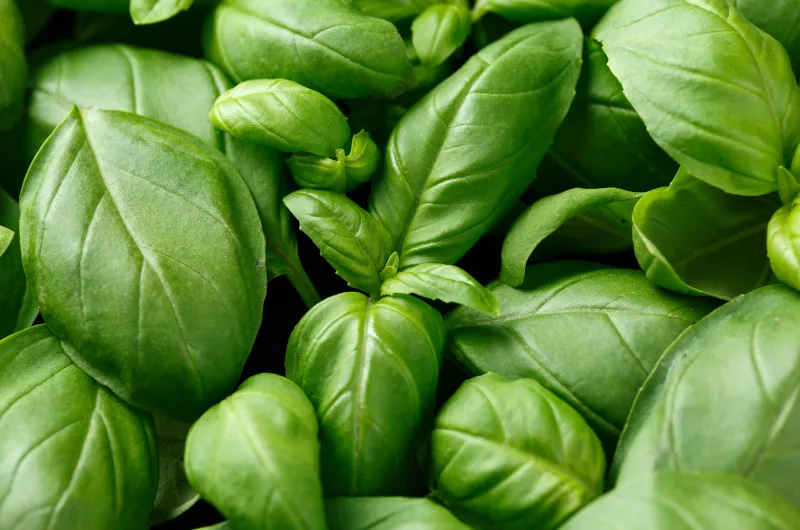How To Grow Basil
Basil is a versatile and aromatic herb that is a staple in many cuisines around the world – and especially popular in Italian dishes such as pizza and pasta (so don’t forget the garlic too!). Most home-grown produce tastes better than shop bought, but basil really takes this to the max. Harvest fresh basil on a warm summer’s day and you’ll quickly realise what we mean! In hot conditions, basil produces significantly more volatile oils, giving its flavour and aroma a dramatic boost. For the ultimate taste experience, try growing your own tomatoes, basil and oregano and use the resulting produce to make your own pizza sauce.
Choosing the Right Variety:
Basil comes in different varieties, each with its unique flavour and characteristics. Common varieties in the UK include Sweet Genovese, Thai Basil, and Purple Basil. Consider the taste and purpose of the basil you want to grow before selecting a variety.
Preparing the Soil:
Basil thrives in well-draining soil that is rich in organic matter. Before planting, prepare the soil by removing any weeds and adding compost or well-rotted manure. This will provide the basil plants with the necessary nutrients to grow.
Planting Basil Seeds:
In the UK, basil is typically grown from seeds rather than transplants. Start by filling small pots or seed trays with a good-quality seed compost. Sow the basil seeds on the surface, following the recommended spacing on the seed packet. Gently press the seeds into the compost and cover them lightly with a thin layer of compost or vermiculite.
Providing the Ideal Growing Conditions:
Basil requires warmth and sunlight to flourish. Place the pots or seed trays in a sunny location, such as a south-facing windowsill or a greenhouse. The ideal temperature for germination is around 20-25°C (68-77°F). Ensure that the soil remains consistently moist but not waterlogged throughout the germination process.
Transplanting Basil Seedlings:
Once the basil seedlings have developed two to four sets of leaves, they are ready to be transplanted into larger containers or the garden. Choose a location that receives at least six hours of sunlight per day. Space the plants about 20-30cm (8-12 inches) apart to allow for proper air circulation and growth.
Watering and Feeding:
Basil plants prefer regular watering, especially during dry spells. Aim to keep the soil evenly moist but avoid overwatering, as this can lead to root rot. Water at the base of the plants rather than overhead to prevent fungal diseases. To promote healthy growth, feed your basil plants with a balanced organic fertiliser every four to six weeks.
Pruning and Harvesting:
Regular pruning is essential for bushier and more productive basil plants. Pinch off the top two sets of leaves from each stem once the plant reaches a height of about 15cm (6 inches). This encourages lateral branching and prevents the plant from flowering too early. Harvest the leaves as needed by snipping or pinching them off just above a leaf node.
Dealing with Pests and Diseases:
Basil is generally resistant to pests and diseases. However, occasional problems may arise, such as aphids or fungal infections. Monitor your plants regularly and take immediate action if you notice any issues. Organic pest control methods, such as handpicking insects or using insecticidal soap, are recommended.
Saving Seeds:
If you want to save basil seeds for future plantings, allow some of your plants to flower and produce seeds. The flowers will eventually form seed heads, which can be harvested once they turn brown and dry. Remove the seeds from the heads and store them in a cool, dry place for the next growing season.
How To Have Year Round Fresh Basil:
Basil loves heat, so will thrive in the summer veg garden, or on the kitchen window sill for quite a long growing season, but it will quickly start to die back as soon as temperatures drop. Most people tend not to heat their kitchens to any great degree, so as winter sets in, growing indoors becomes less practical. You could potentially grow basil in the living room, but the aroma from the plants is quite strong, so may become intrusive.
Whilst the plants are thriving, we’d recommend regularly harvesting the leaves and either drying or preserving for use in in the colder months. Basil can be dried by cutting off shoots, bundling them up and hanging them somewhere warm until all moisture has gone from the leaves. The leaves can then be stored in a jam jar or other sealed container, reducing the need to resort to shop bought dried basil.
A better idea though is to freeze basil. The best way to do this is in an ice-cube tray. Fill each cube tray with basil leaves, then cover with water before freezing. Using this method, most of the oils are retained, giving much better flavour in your cooking.
Whether you use it in Italian dishes, Thai curries, or as a fragrant addition to salads, having fresh basil on hand will undoubtedly enhance your culinary creations.



